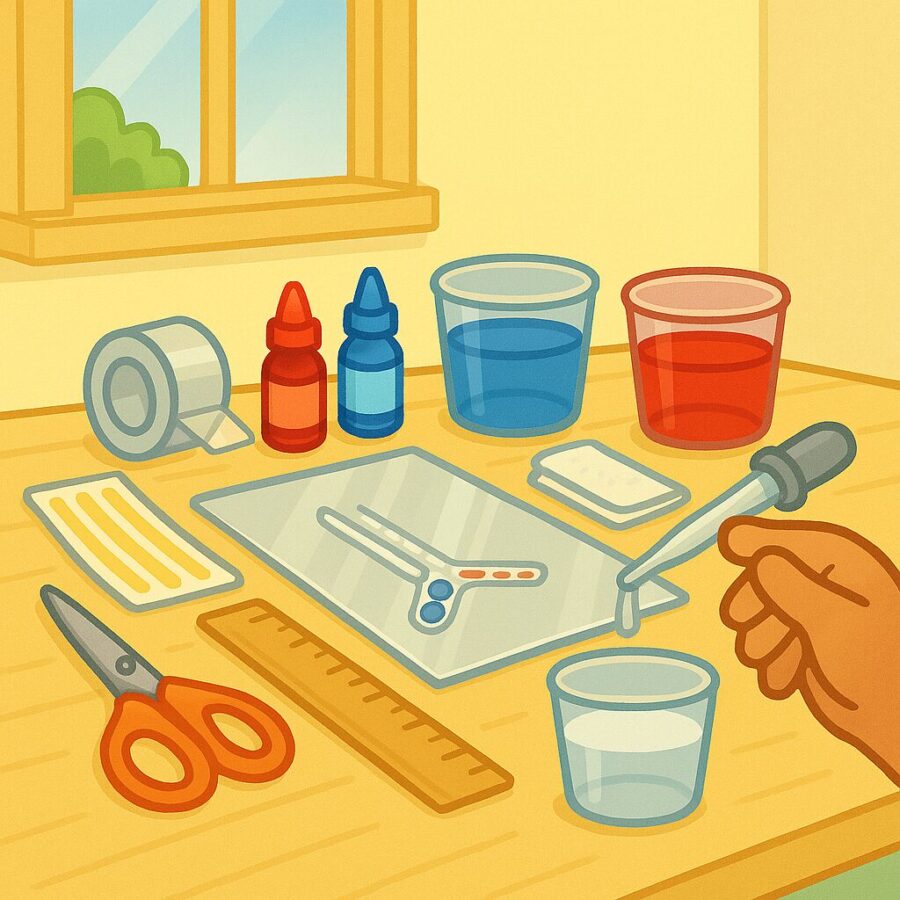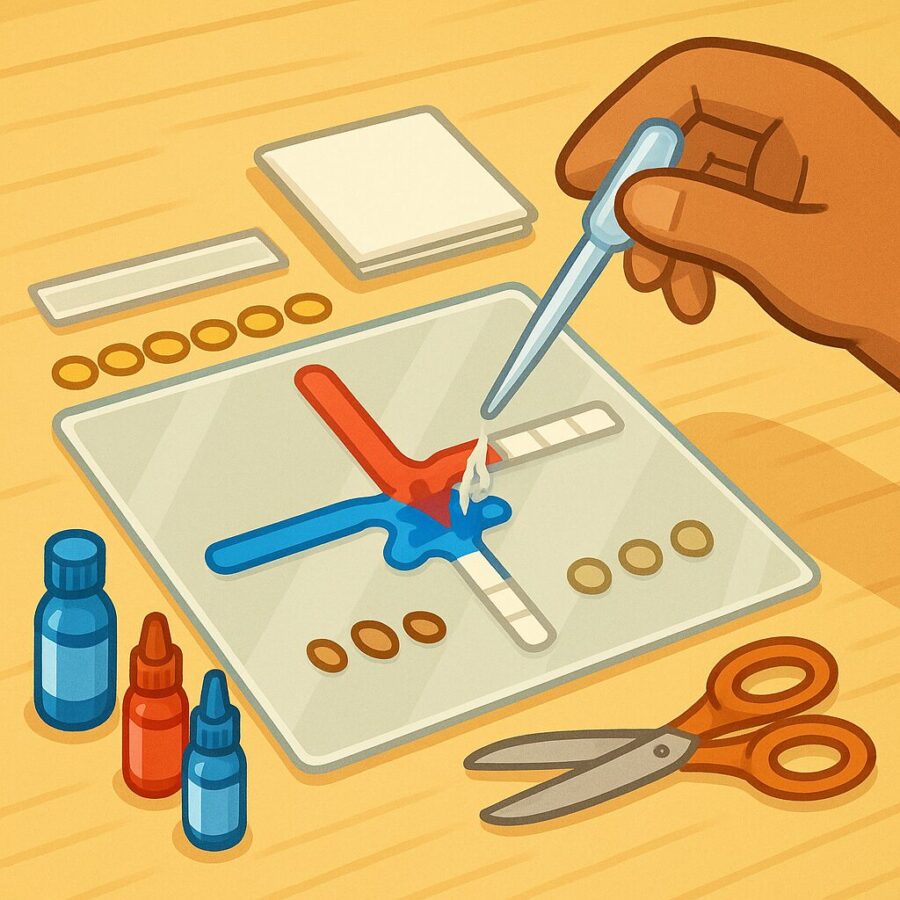 Sticker Microfluidics:
Sticker Microfluidics:
Explore Microscale Fluid Dynamics with Stickers and Colored Water!
Explore Microscale Fluid Dynamics with Stickers and Colored Water!
Microfluidics might sound like something out of a laboratory, but your students can explore this cutting-edge science using nothing more than stickers, plastic, and colored water! In this hands-on sticker microfluidics experiment, learners build simple channels to observe how fluids behave at the microscale. This activity introduces real-world STEM concepts behind medical diagnostics, chemical analysis, and fluid engineering—all while creating colorful, engaging designs.
Designed for middle schoolers but accessible to curious learners of all ages, this experiment invites creativity, problem-solving, and scientific reasoning. Watch as your child creates paths with stickers and sees how tiny amounts of liquid travel through homemade channels. Whether you’re studying engineering design, fluid mechanics, or chemistry, this project connects abstract ideas with tactile experience.
Overview
- Grade Level: 6th–9th Grade
- Topic: Microfluidics, Fluid Dynamics, STEM Design
- Estimated Time: 30–45 minutes
- Mess Factor: Low
Purpose: This experiment helps students understand how fluids move in confined channels using common household materials to model microfluidic technology.
Hypothesis: If I create tiny channels with stickers and flow colored water through them, then I can observe how fluids move, mix, or stay separate depending on the channel design.
Materials
- Clear plastic sheet (transparency film or a plastic folder), about 8 x 10 inches
- Clear adhesive tape (approx. 1 inch wide)
- Removable stickers (dots, strips, or shapes)
- Food coloring (at least 2 different colors)
- Water (about 1 cup total)
- Pipette, dropper, or syringe
- Ruler (in inches)
- Scissors
- Plastic tray or baking dish (to catch spills)
- Paper towels

Step-by-Step Instructions
- Clean the plastic sheet so it is dry and free of dust.
- Use the stickers to create narrow paths (channels) about 1/4 inch wide on the plastic. Leave gaps between stickers to form open channels.
- Design intersecting paths or T-junctions to observe fluid interactions.
- Seal the sticker design with clear tape, pressing firmly to remove air bubbles and prevent leaks.
- Prepare colored water by mixing food coloring into small amounts of water in separate cups.
- Using a pipette, drop colored water at the entry points of your channels. Observe how it flows, meets, and mixes (or not!).
- Record observations and test different designs for new effects.

Scientific Concepts
Microfluidics is the science of manipulating fluids in very small spaces—often narrower than a human hair. These systems are used in real life to perform medical tests (like rapid diagnostics), analyze chemicals, or move tiny droplets in controlled ways.
At the microscale, fluid behavior changes dramatically. In large pipes or rivers, gravity and momentum dominate. But in microfluidic devices, surface tension and capillary action take over. These forces cause fluid to behave more like gel than water. That’s why even tiny changes in your sticker design—like a curve or intersection—can affect how fast or whether colors mix at all.
This is the same physics used in devices called “lab-on-a-chip,” which can perform dozens of experiments in a single drop of fluid. Scientists use materials like glass or silicone etched with channels, but your stickers and tape do the same job at a smaller scale.
Key ideas to teach:
- Surface Tension: The cohesion of water molecules creates resistance to flow in small channels.
- Capillary Action: Liquid can travel through narrow paths even without gravity.
- Viscosity: Thicker fluids move more slowly—try the experiment again with syrup or oil!
- Fluid Mixing: Depends on how fast fluids move and how their channels interact.
Design Challenges
- Create parallel channels and observe whether colors ever mix.
- Build a junction where two channels meet. Try placing drops at the same time—what happens?
- Make a spiral or maze—how far can your water go?
- Compare straight vs. curved channels—do curves slow things down?
- Use different fluids (oil, milk, syrup) to compare flow behavior.
Learning Objectives
- Understand principles of fluid flow in small-scale environments.
- Observe and document physical behavior in custom-designed microchannels.
- Explore engineering design by building and testing prototypes.
- Identify real-world uses of microfluidics in health, research, and manufacturing.
Worksheet & Generator
Download your ready-to-use worksheet or use our generator to design your own science experiment!
Frequently Asked Questions
Microfluidics is used in medical diagnostics (like pregnancy or COVID tests), chemical analysis, DNA amplification, drug testing, and even inkjet printing. It allows precise control over very small volumes of liquid, enabling tests that require only a single drop of blood or fluid. It’s also widely used in environmental monitoring and biotechnology.
Yes! Although designed for middle school, younger children can enjoy this experiment with help. They can lay out stickers, use a dropper, and observe the colorful paths. It’s a great introduction to basic physics and engineering ideas with a fun, hands-on twist.
Not always. Whether fluids mix depends on channel design, flow rate, and how much fluid is used. You may see clean separation, gradual blending, or swirling patterns—all of which are valid and interesting results to discuss.
Definitely! Using other liquids introduces variables like viscosity and surface tension. Milk will behave similarly to water, but thicker substances like syrup or oil will flow slower and may not mix easily. This is an excellent way to expand the experiment into a more advanced fluid dynamics project.
Related Experiments
- Banana DNA Extraction
- Germ Spreader Challenge
- Plant Growth Light Experiment
- See All Science Experiments
Share Your Results
Did you build your own microfluidic masterpiece? We’d love to see your channels, your results, and your creative twists! Tag us @homeschoolgenie or drop a comment below.
⭐ What Parents & Teachers Are Saying
Recent Feedback
There are no reviews yet. Be the first one to write one.

